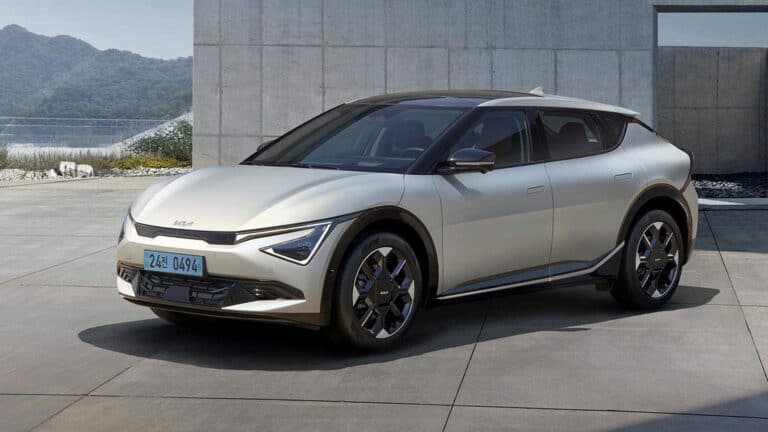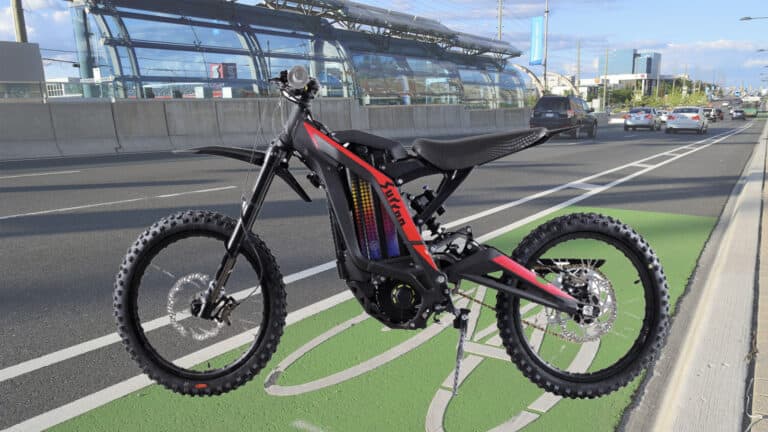- The AIMA Santa Monica e-bike features a unique 750W motor, which is 50% more powerful than the motors in most city e-bikes.
- It incorporates a torque sensor for a natural and efficient riding experience, distinguishing it from bikes with cadence sensors.
- The Santa Monica e-bike has a user-removable 720Wh battery integrated into the down tube and supports a range of up to 60 miles on a single charge.
- The Santa Monica e-bike reaches a top speed of 28 mph, categorizing it as a Class 3 e-bike, which supports higher speeds with pedal assist.
AIMA has their first commuter e-bike, called the Santa Monica. It has a class-leading 750W motor, a torque sensor, a step-through frame, and a 720Wh battery.
ADVERTISEMENT
Who Is AIMA?
AIMA is the second-largest manufacturer of bicycles and scooters in China, with 12 factories in eight different cities. They know what they’re doing, with decades of experience. The brand is only starting to become known here, as they just launched their first two bikes in the U.S. last year. The bikes are designed here in the U.S. to American-specific specs.
Their American team has already partnered with over 200 bike shops across the country to sell and service their bikes. They don’t sell consumer-direct because their philosophy is that e-bike assembly can be difficult, and having it assembled by a professional tech at a bike shop will offer a better experience.

Their first bike, launched last year, is the fat-tired Big Sur. It has a step-through frame, 26” x 4.0” tires, and a 750W Bafang rear hub drive. It sold very well for the first year in the U.S.
They followed that up with the Big Sur Sport — similar specs but with smaller 20” x 4.0” tires. All their battery systems are UL-certified, all of their bikes have a torque sensor. I’ll explain why that’s important shortly.
AIMA Santa Monica E-Bike Specs
| Specification | Details |
| Price | $1599 |
| Frame | Aluminum, step-through |
| Fork | SR Suntour 27.5” suspension fork with thru-axle |
| Motor | 48V, 750W Bafang brushless geared rear hub motor |
| Battery | 48V 720Wh LG 21700 li-ion cells |
| Controls | Bafang, color TFT |
| Charge Time | 3 hours |
| Top Speed | 28 mph |
| Range | Up to 60 miles (claimed) |
| Rear derailleur | Shimano Altus, 8-speed |
| Brakes | Tektro hydraulic disc brakes w/ 203 mm rotors |
| Saddle | Comfort |
| Rims | Aluminum |
| Tires | 27.5” x 2.6” |
| Color Choice | White, black or blue |
| Sizes | Small, medium |
| Warranty | 2 years (motor system, bike) |
ADVERTISEMENT
Introducing the AIMA Santa Monica E-Bike
For 2024, AIMA is getting into the biggest e-bike segment: commuter bikes. They have been using California location names, so this one is called the Santa Monica.
It features an exclusive new motor from Bafang designed specifically for AIMA’s e-bikes, and they’re calling the motor “Route 66.” That motor provides 750W of power, delivered using a torque sensor.

The 750W motor is more powerful than almost any other city e-bike on the market, which all tend to have 250-500W motors. Because of the new design, the Route 66 motor is the size of a 500W motor, but it puts out 50% more power than a 500W bike would.
The 720Wh battery is fitted into the down tube and is user-removable with a key. This is great for winter storage, as you can keep the battery inside. You can always take the battery off for charging, though you can also charge it right on the bike.
Torque Sensors vs. Cadence Sensors
Torque sensors measure how much human power of your own is going into pedaling, then it adds power from the motor to match. It feels very natural and can start assisting you as soon as you start to pedal. Torque sensors used to be available mostly in bikes with mid-drive motors — often higher-end, higher-priced models. This trend of putting them in lower-priced, hub motor-powered bikes is simply fantastic!
ADVERTISEMENT
In comparison, bikes with cadence sensors only will take a full revolution of the pedals before they start adding motor power in, then as long as the pedals are moving, the motor will give you the full power of whatever mode you are in. For example, if you’re in mode 1, it might take you up to 12 mph, mode 2 might take you to 15 mph, and so on. But it does this often abruptly.
The bikes with torque sensors, like the Santa Monica e-bike, in addition to feeling natural, generally are more efficient and give you longer range. The Santa Monica claims to get up to 60 miles of range per charge. As a Class 3 e-bike, you can use the throttle up to 20 mph, and pedal assist brings you up to 28 mph.
The SR Suntour suspension is well-specced for commuter bikes. It offers 60 mm of travel, enough to take the shock out of bumpy roads. The large-volume 27.5” x 2.6” tires will also help smooth the ride. The Santa Monica e-bike comes stock with sturdy plastic fenders to keep the splashes off of you if you ride through rain or puddles, and it’s IPX4-rated, so it’s protected against light rain.
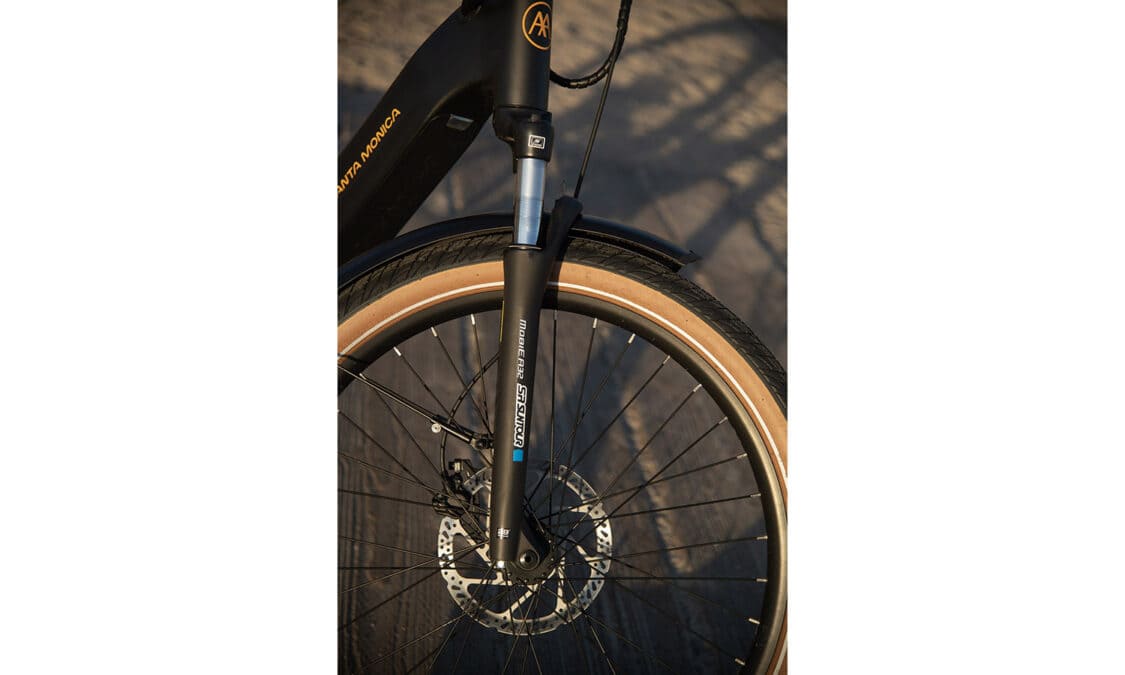
A Shimano Altus 8-speed drivetrain helps get you moving. Altus is on the lower end of Shimano’s offerings, but it’s still really good. Tektro hydraulic disc brakes with 203 mm rotors will offer ample stopping power.

Touch points include leather grips and a huge, padded leather seat, along with aluminum platform pedals. There’s a bright 100 lux headlight, a color TFT display, and a throttle for times you don’t want to pedal. There are turn signals and a horn. The horn is loud and the turn signals beep obnoxiously loudly when actuated. Unless you’re deaf, you’ll always know when they’re on.
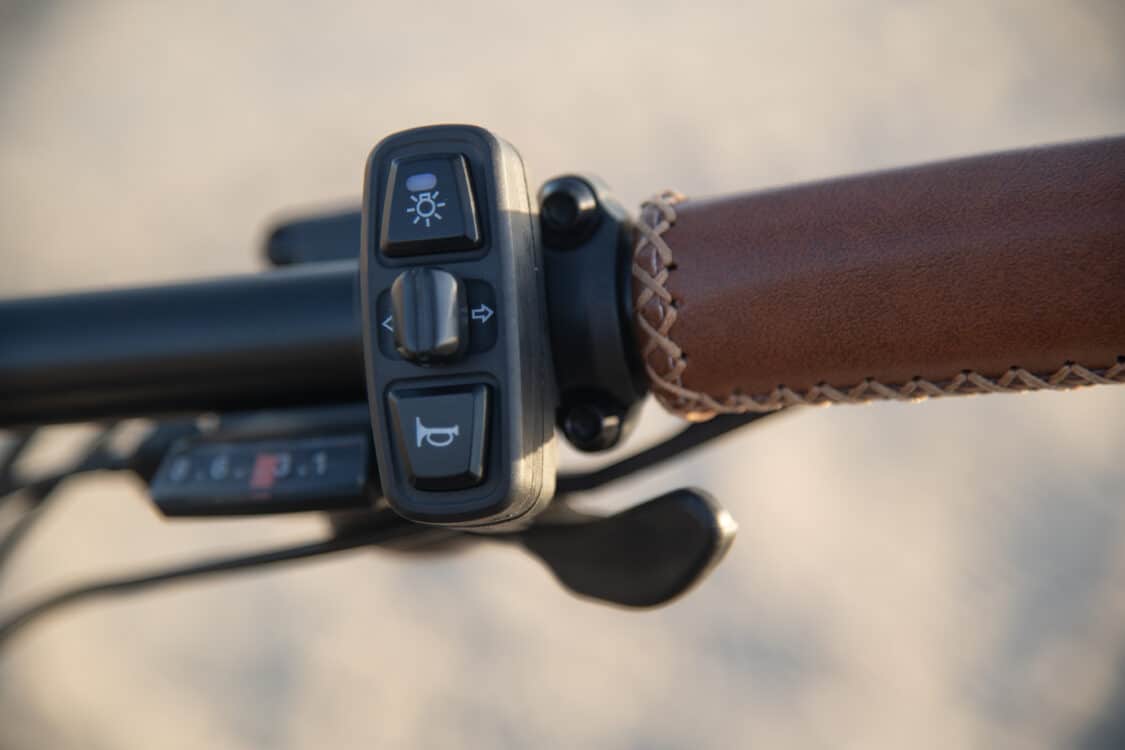
ADVERTISEMENT
From Challenge to Comfort: The Santa Monica’s Ride Experience
Weighing in at 66 lbs, the Santa Monica e-bike presents a challenge for those of us living in apartments with stairs, especially since it’s 4 lbs heavier than its close competitor, the Aventon Level.2. Despite this, both bikes deliver an exceptional ride. However, hauling the Santa Monica upstairs after a ride proves to be a bit of a struggle, not to mention it exceeds the weight of my hitch-mounted Hollywood Rack by a pound.
But once you turn on the bike and throw a leg over, you’re in for a fun time. It offers power immediately but naturally. The 26” x 2.6” tires glide nicely over the road, and between their volume and the little bit of travel from the SR Suntour fork, bumpy roads feel less bumpy. They have retro-reflective strips on the side for better visibility at night.
There are five levels of assist, and you can definitely feel the difference between each level. Even in the lowest level, 1, the bike offers plenty of power. The motor is quiet, with a very light hum barely audible over the sound of the tires on the pavement.
The 8-speed Shimano Altus drivetrain with trigger shifters offers a good range of gears even for some of the steep hills I took it up. The handlebar has a pretty big sweep back, which some riders will feel more comfortable with than a flatter bar (my preference is the latter). The stem is adjustable for various heights to also enhance rider comfort. You will need Allen wrenches to adjust it.
It’s nice to have the premium quality and control of hydraulic disc brakes. The Tektro brakes on this are great, paired with 203 mm rotors front and rear. There’s more than enough stopping power, and they’re easy to modulate.
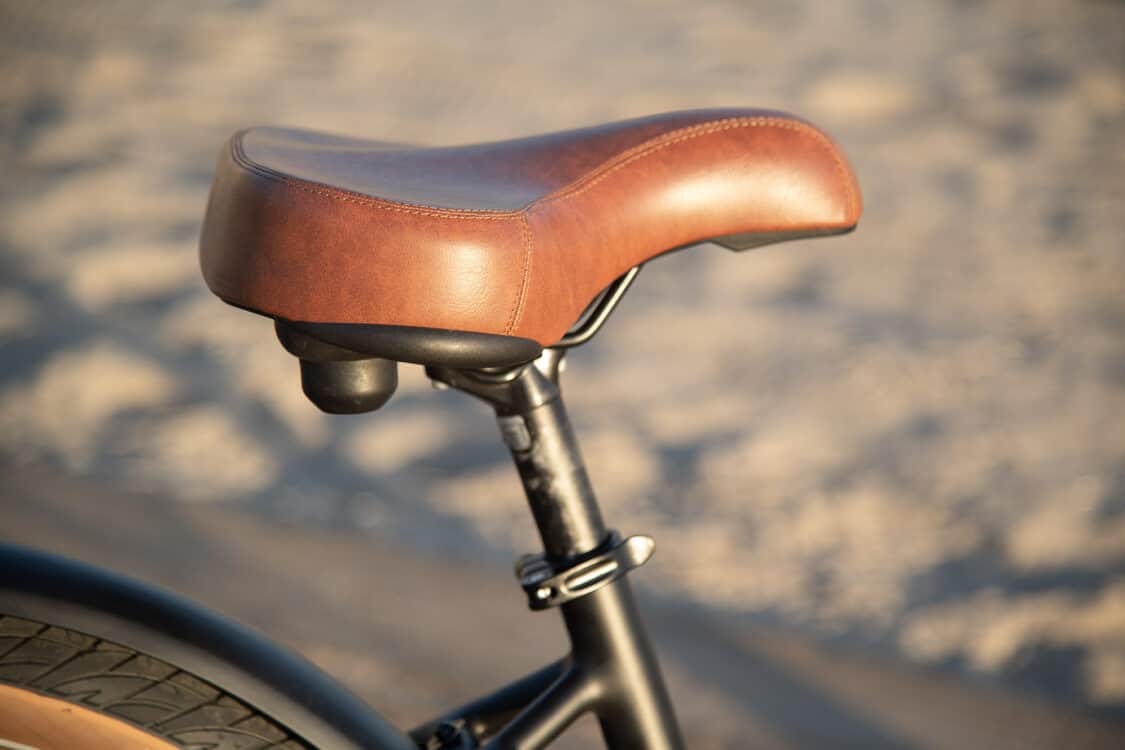
For most riders, the adjustment on the seat will let you adjust it for yourself, and if there’s enough room, you could add a suspension seatpost for an even cushier ride. For this electric bike, AIMA opted for a huge, highly padded seat, similar to the one on the Big Sur. I know why they do it: It’s a comfortable seat that will fit nearly everyone, and almost everyone will find it comfortable. It also adds about 5 lbs to the bike, though. If I were buying this bike, I’d likely swap it out for a lighter, fitted one, like the ones from SQ Lab.
ADVERTISEMENT

IMAGES: TONY DONALDSON
FTC: We use income-earning auto affiliate links. Learn more.







